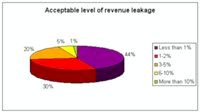Network operators have a fair way to go in tackling revenue leakage before they reach acceptable target levels. That is the conclusion drawn by Informa Telecoms and Media in its latest report OSS STRATEGIES FOR ACHIEVING REVENUE ASSURANCE.
Participants in a survey, carried out as part of the research for the report, were asked what they believed was an acceptable level of revenue leakage as a percentage of total revenues.

Acceptable level of revenue leackage. Source: Informa Telecoms & Media
The majority of respondents felt either that revenue leakage should be less than 1 percent (44 percent of responses) or that revenue leakage was acceptable within the 1-2 percent range (30 percent of responses).
"This majority response of operators in this survey demonstrates that the industry in general has the right attitude toward revenue leakage — keeping it as low as possible," comments Andy Bairsto, author of the report and Principle Analyst at Informa Telecoms and Media. "However, the 5 percent of respondents who believe that an acceptable level of revenue leakage is 6-10 percent cannot be treated as an anomaly and it points towards a segment of the industry that is clearly not placing enough credence to issues relating to revenue assurance."
Respondents were also asked to identify current revenue loss as a percentage of total revenues in order to give an idea of how big a problem revenue leakage was. The majority of responses fell into one of two ranges — either 1-2 percent or 3-5 percent, both of which attracted 32 percent of responses. Only 6 percent of respondents claimed to have revenue losses of less than 1 percent.
More worrying was that 15 percent of respondents said leakage was 6-10 percent and 4 percent had losses running направляться over 10 percent.
"Comparing the responses to these two questions shows there is a big discrepancy between what operators perceive as an acceptable level of revenue leakage and the levels that they are admitting to," says Bairsto.
The survey goes on to determine, among other things, whether it was felt that levels of revenue leakage had improved or declined in recent years; what industry experts thought were the key reasons for revenue leakage; and why they thought it was important to keep leakage to a minimum.
The survey also aims to gain some perspective on what operators were doing to tackle revenue leakage in their own organisations.
The full report provides independent analysis of the reasons for fraud and how it can be tackled in each of the following areas: subscription fraud, internal fraud, partner fraud, prepaid fraud and roaming fraud. It takes the view that revenue assurance should be seen as an end-to-end process, rather than simply as the process of reconciling one set of accounts against another.
© "Informa Telecoms & Media"